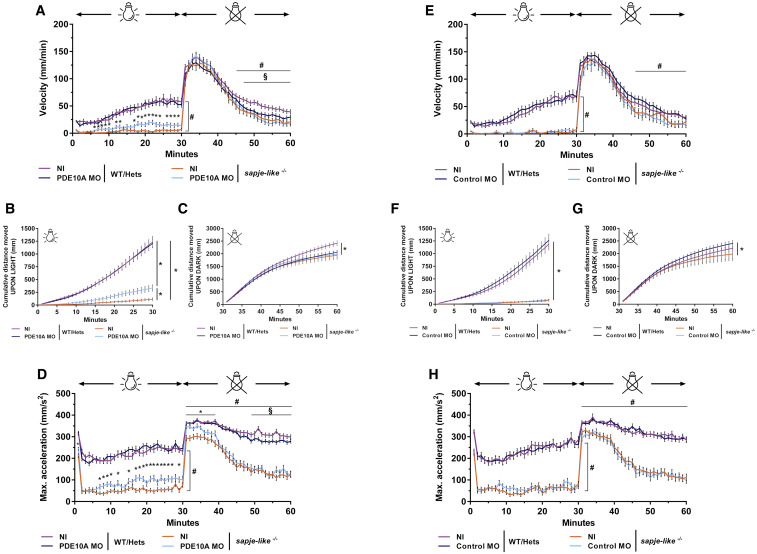Fig. 4 Improvement in Locomotion of pde10a Morphant Dystrophin-Deficient Zebrafish Pairs of sapje-like+/− zebrafish were mated and pde10a morpholino or standard control morpholino (negative control) was injected in one-cell-stage progeny embryos. At 4 dpf, a birefringence assay was performed and unaffected larva (normal muscle birefringence phenotype) as well as affected larvae (abnormal muscle birefringence phenotype) were set in 48-well plates. At 5 dpf, following a dark period of acclimation, a light/dark locomotion assay was performed in the DanioVision observation chamber (Noldus) and data were generated from EthoVision XT tracking software (Noldus). In each experiment, morphant zebrafish were compared to non-injected siblings. At the end of the experiment, fish were collected and genotyped. (A–D) pde10a morpholino experiments. (E–H) Standard control morpholino experiments. (A and E) Graphs show swimming velocity (mm/min) for the entire assay. # indicates statistical differences between NI SL−/− and NI WT/Hets larvae; asterisk (∗) indicates statistical differences between NI SL−/− and pde10a morphant SL−/− larvae; § indicates statistical differences between NI WT/Hets and pde10a morphant WT/Hets (p < 0.05, t test, ±SEM). (B and F) Graphs show cumulative distance traveled (mm) for 30-min light period. Statistical differences between groups are presented as follows: ∗p < 0.05 (t test, ±SEM). (C and G) Graphs show cumulative distance traveled (mm) for 30-min dark period following light-to-dark transition. Statistical differences between groups are presented as follows: ∗p < 0.05 (t test, ±SEM). (D and H) Graphs show maximum acceleration capacity (mm/s2) for the entire assay. # indicates statistical differences between NI SL−/− and NI WT/Hets larvae; asterisk (∗) indicates statistical differences between NI SL−/− and pde10a morphant SL−/− larvae; § indicates statistical differences between NI WT/Hets and pde10a morphant WT/Hets (p < 0.05, t test, ±SEM). From 90 to 230 (n = 90–230) zebrafish were analyzed per condition within at least four (N = 4) independent experiments.
Image
Figure Caption
Figure Data
Acknowledgments
This image is the copyrighted work of the attributed author or publisher, and
ZFIN has permission only to display this image to its users.
Additional permissions should be obtained from the applicable author or publisher of the image.
Full text @ Mol. Ther.

